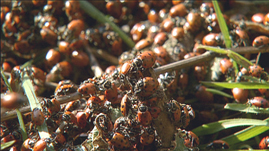Teachers' Domain - Digital Media for the Classroom and Professional Development
User: Preview


Source: QUEST:"Ladybug Pajama Party"



This video segment, adapted from QUEST, explains the unique behavior of a species of ladybug that spends most of its year feeding on the California coast but then migrates by the millions inland to spend the winter. Once they reach their destination, they huddle together to maintain temperature and moisture level in order to survive.
The San Francisco bay area is well known for its numerous micro climates. On any given day, there can be a twenty degree temperature difference in cities, or towns separated by only a few miles. In the same year, some areas may flood and others experience near drought conditions.
The convergent ladybug or, Hippodamia convergens, is an insect that is commonly found here in the Bay Area at different times of year. This species of ladybug migrates seasonally as temperatures within the micro climates change. Most organisms have specific internal and external mechanisms that aid their survival amid varying weather conditions. Chief among them are migration, hibernation, and various types of thermoregulation.
Human beings naturally maintain a body temperature of around 98.6 degrees. This is the optimal temperature at which the body is able to optimally perform its functions. When the our body's temperatures begins to fall below normal, it responds by activating a number of countermeasures designed to increase body temperature. Shivering, for example, is a common symptom of falling body temperature. If body temperature continues to fall, we develop hypothermia. On the other hand, if body temperature increases above normal, we begin to initiate countermeasures intended to cool us off. Sweating is a rather cleaver way that our body is able to cool itself. If we are unable to stop body temperature from rising, we develop hyperthermia. This ability for our own bodies to regulate temperature makes us endothermic.
Even though most mammals and birds are endothermic, they still rely on other methods of maintaining body temperature. Insects and reptiles, on the other hand, are ectohermic, meaning that in order to keep their internal body temperatures normal, they rely heavily on external conditions. For example, reptiles are often found sunbathing as a way to keep their bodies warm. To stay cool, they often try to find shady areas and or live near water. It was once though that insects and reptiles were completely ectothermic and were commonly referred to as "cold-blooded." However, it is now known that these animals are not completely dependent of external means of regulating body temperature.
Like the convergent ladybug, many insects migrate as a means of aiding in thermoregulation; finding cooler or warmer temperatures, they often move short or long distances in order to survive.
To learn more about animal migrations, check out Migration of the Monarch and Marathon Migrators.
 Loading Standards
Loading Standards